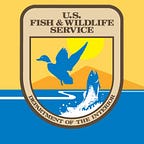“House Hunters” Common Eider-Style
Finding the Best Nest in the Arctic National Wildlife Refuge
Common eiders, the hardy sea ducks that they are, have some serious considerations when searching for a place to nest. They nest in the high north, such as along the coastal areas of the Arctic National Wildlife Refuge, where it’s anything but easy to raise a family. They’ve got the elements to deal with — where the never-ending rain and wind is intense and everything that can eat eggs, will try to.
All of this makes nest selection a crucial decision in an inarguably harsh landscape. In fact, if common eiders were stars of an episode from “House Hunters,” we think this is what it would look like…
His and Her Must-Haves for a Nest:
HIS
Doesn’t care* — flies off
*In the population of eiders we’re talking about, the males don’t play a role in nesting*
HERS
- A neighborhood she can’t see herself in (because, camouflage)
- Low egg-crime
- Food within waddling distance
Budget:
With her “Eiderdown” business and being a barista at a local coffee shop, her budget is 1,000,000.*
*Eiders don’t actually use money or have a budget.
A Neighborhood She Can’t See Herself In
Female common eiders are looking for a location that allows them to blend in perfectly with their surroundings. This is especially important because they are “stay-on-nest-moms (SONM),” and spend over 99% of the time at home during incubation. That’s 26 days on their nest! Blending is key to avoid being noticed or bothered — or eaten. Finding the right neighborhood to do this is critical, and luckily, their feathers, which are a lovely mottled brown and gray, help them cryptically blend in a variety of places. In the Arctic refuge, they’re inclined to nest along sandy spits and pebbled islands all along the coast. They have no desire to draw attention to themselves in their neighborhood — especially when they might have hungry neighbors.
Low Egg-Crime Rate
Lots of creatures eat eider eggs, so a momma eider needs to find an area with low-egg crime. In the Arctic, glaucous gulls and other birds, as well as foxes, grizzly bears, and even polar bears will raid nests. As a result, mother eiders look for places that won’t attract a lot of hungry neighbors — often places that are difficult to access. Sometimes they’ll even build their nests on islands with lots of loud and gregarious nesting gulls. That way, they have plenty of warning if a large predator approaches.
Food within Waddling Distance
Since we know momma eiders fast for their eggs’ entire incubation period, we know they’re hungry when the eggs finally hatch and the ducklings are hungry too! It’s because of this, the nest needs to have close access to water full of invertebrates like insects and mollusks. Only a day or so after hatching, she’ll lead her family to water where they will gorge on all things squirmy and crawly. Places like the Arctic National Wildlife Refuge are host to lots of tasty invertebrates — with summer bringing lots of tasty things for the babies to eat. The ducklings have also got to eat a ton and grow a lot in a short time to be ready to fly in time for the next school-er migration year. So having lots of food nearby is a must.
Deal Breakers
Things they just won’t deal with. Period.
Flooding
A beachfront property does come with some risks, and sometimes nests are lost to flooding. They can’t have a nest that floods before the ducklings hatch!
Predators
Momma eider will abandon the nest she’s made when a predator approaches. She flies off but will return to check on the nest incase any eggs were left unharmed.
Eiders seeking the perfect spot don’t shy away from a fixer-upper or more rustic locations. They are often drawn to nesting in similar areas where even they were raised. But flooding and predators remain definite deal-breakers.
Landing the Ideal Location
Meeting all the nesting requirements, the North Slope provides the area that the eiders selected, preferring this beachfront property. This neighborhood has easy access to the ocean and plenty of food sources. There’s shabby chic driftwood to help slow down biting arctic winds while having a modern feel. In a location like this, they can swim, dive, and feed nearby. Assuming it there’s no obvious flood damage, this would be an ideal nest to make an offer on.
Making the Nest Decision
For common eiders, “house-hunting” is an important investment in the future of the species — especially along the coast of the Arctic National Wildlife Refuge. Common eiders are some of the most interesting birds around and are survivors in an ecosystem that offers both vital support and unique challenges. Eiders can live for about 20 years, so each time they successfully raise a family, it’s an important boost for the population. We’ve noticed that though they’re called common eiders, their population has dropped quite a bit since the housing boom in the 50’s and so the Arctic National Wildlife Refuge staff and University of Alaska Fairbanks have teamed up on several ongoing studies and are working hard to learn more about common eiders.
By Danielle Brigida, National Social Media Manager
U.S. Fish and Wildlife Service
